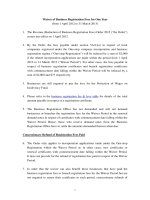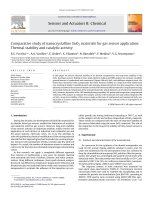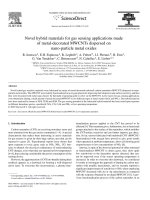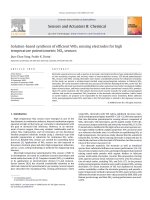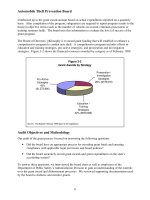Synthesis of work exchange networks for gas processing applications `1
Bạn đang xem bản rút gọn của tài liệu. Xem và tải ngay bản đầy đủ của tài liệu tại đây (69.36 KB, 9 trang )
Chapter 1 Introduction
CHAPTER 1
INTRODUCTION
Energy is the major global concern of the 21st century. Energy consumption by the
world’s population has seen great increases over the years. For instance, in the past
decade alone, energy consumption has increased from 2573.8 mtoe (million tonnes of oil
equivalent) in year 2000 to 3981.9 mtoe in year 20081. This is an increase of
approximately 55% in a decade, averaging over 5% per annum. Such energy trends are
expected to further increase into the future as many developing countries will continue to
industrialize and experience rapid growth in population as well as improving living
standards. The worldwide energy demand2 is predicted to rise by as much as 57% during
2004 to 2030. In the USA, the total primary energy consumption is expected to grow
0.5% annually from 2007 to 2030. The industrial sector was the largest consumer of
energy in the USA claiming about 28% of the total energy consumption in 20072.
The fossil fuels (oil, coal, and NG) currently supply over 85% of the worldwide
energy demand while the rest is supplemented by nuclear and green initiatives such as
solar, wind, bioenergy, and hydroelectricity. The use of fossil fuels is projected to rise by
27% over the next 20 years3. Petroleum, NG, and coal release 139-225, 115-140, and
205-228 lb of CO2 respectively for one million Btu of energy2. Clearly, their impact on
environment is significant. Our first line of defense against these emissions and the
resulting climate change is energy conservation (or using these fuels as efficiently as
possible). The fast depletion of oil reserves, rising demand of energy, uncertainties in
energy prices, technologies barriers in renewable energy, concerns over energy security,
1
Chapter 1 Introduction
and strict environmental regulations on CO2 emissions are among the several driving
forces underlying the need for energy conservation.
1.1 LNG Processes
Among the aforementioned fossil fuels, NG seems to be the most promising source of
energy to power the future economy. NG consists predominantly of methane
(approximately 90%) with small amounts of ethane, propane and nitrogen as well as trace
quantities of heavier hydrocarbons such as butane and pentanes. It is currently the
cleanest burning fossil fuel, producing significantly lower amounts of carbon dioxide,
nitrogen oxides, sulfur oxides and particulates2. With the current global phenomenon of
global warming and the push for greener initiatives, NG seems to be the ideal short term
solution to the global pollution problems or at least until other greener initiatives become
commercially viable. According to the Energy Information Administration (EIA)2, NG is
the fastest growing energy source and its consumption is expected to increase over 48%
between year 2006 and 2030.
Most NG reserves are stranded and located offshore, far away from any demand
centers. Hence, the transportation of NG from the point of production to the markets is a
technical and commercial challenge. A popular solution would be to transport
compressed NG through pipelines. However, such pipelines are geographically restricted
and may not be economically feasible. In addition, energy security may be easily
compromised. An attractive alternative would be to liquefy NG into LNG and transported
in specially insulated shipping tankers. When liquefied, LNG takes only 1/600th of the
NG volume at ambient temperature and pressure4. This drastic reduction in volume
makes long distance transport of LNG technically and economically possible. An LNG
2
Chapter 1 Introduction
tanker has the capacity of transporting an equivalent of several billion cubic feet of NG. It
was reported in year 2008 that at least 27.8% of international trade in NG is in the form
of LNG and continued future increases are expected1.
The adoption of LNG as a mode of transportation in the early 1960s and 1970s
were slow due to high capital costs of LNG facilities which includes liquefaction trains,
storage facilities, and loading/unloading jetties. In addition, LNG production is an energy
intensive process due to the need for large compressors to provide refrigerant between
ambient temperature and cryogenic LNG temperature of 111K. Therefore, energy
efficiency of the liquefaction process is an immediate concern in any LNG project or
operation. Classical technologies include the cascade process by ConocoPhillips where
refrigeration is provided through a cascade of pure refrigerants. Other processes utilize
mixed refrigerants (MR) which includes Shell’s DMR, Air-Products’ C3MR and AP-XTM
refrigeration system. Technological and process advancements have driven down the
energy requirements and improved energy efficiencies to approximately 5.5 to 6.0 kWh
of energy per kmol of LNG produced5. Despite such improvements, LNG production is
still relatively more costly in comparison to other fossil fuels such as crude oil and coal.
With increasing energy costs and stricter environmental protection legislations, further
improvements and optimization of LNG processes are necessary and has been gathering
the attention of academic and industrial researchers all around the world.
In view of this, it is, therefore, in the interest of this work to pursue the
optimization of the latest LNG production process, AP-XTM refrigeration system patented
by Air Products in 20016. As this system is relatively new and the world’s first AP-XTM
LNG train was only recently built and commissioned in Qatar in May 20097, it presents a
3
Chapter 1 Introduction
unique opportunity to study the optimal operation of the system as it had not been the
subject of extensive studies by academic researchers as compared to more established
processes such as the cascade and C3MR processes. As compressors are the preeminent
consumers of energy, a systematic optimization approach to minimize compressor power
requirements in the AP-XTM refrigeration system can be valuable with respect to
operations and power consumption. A brief explanatory is provided to understand the
basics of the refrigeration process.
1.2 Refrigeration Process
Refrigeration is a process in which work is done to move heat from one stream to
another. It includes five basic components refrigerant fluid, evaporator, compressor,
condenser, and expansion valve. In order to operate the process successfully, each
Throttling
Valve
Compressor
component must be optimally operated.
Figure 1.1 Schematic of a Basic Single Refrigeration Cycle
4
Chapter 1 Introduction
Figure 1.1 represents a simple (one cycle) refrigeration cycle. Refrigerant
removes heat from the product in the evaporator by vaporizing itself. Then, refrigerant
passes through compressor to obtain higher pressure so that it can remove heat to
condenser utilizing cooling water. This pressure is very important for the condensation of
the refrigerant in the condenser and depends on the cooling water inlet temperature. For
example, if cooling water temperature increases, then high compressor outlet pressure is
required for refrigerant and thus, increases power consumption by the overall
refrigeration cycle. Then, condensed refrigerant passes through a throttling valve where it
undergoes further expansion to reduce its temperature. These condensed, low
temperature, and low pressure refrigerant enters evaporator to provide cooling duty to the
process stream.
The following sections discuss about the energy intensive compression and
expansion process and the importance of LNG processes.
1.3 Compression and Expansion Processes
Plants are required to compress gas to meet process conditions. These compression works
are done by different types of compressors such as reciprocating compressor, and
centrifugal compressor. Note that this work is intended to centrifugal compressors that
are being mostly used in chemical industries and thus, we limit our discussion in this type
only. Compression process is highly energy intensive in many chemical plants (Table
1.1) such as gas processing and transportation, Liquefied Natural Gas (LNG), refineries,
petrochemicals, air enrichment, ammonia, and fertilizer. Due to its highly energy
intensive nature, we should ensure optimal design, synthesize, and operation of the
compressor network. However, its performance depends on several factors such as stream
5
Chapter 1 Introduction
temperature, pressure, composition, compressor type, speed, availability etc. which make
its design and operation much more complex.
Table 1.1 Industrial applications of centrifugal compressors
Plant
Process
Refineries
Petrochemicals
Synthesis
Natural Gas
Others
Service
Catalytic Cracking
Air Comp, Gas Comp
Catalytic Reforming
Gas Recycle
Catalytic Desulfurization
Gas Recycle
Lube Oil
Fuel Gas, propane
Ethylene
Charge Gas, Refrigeration
Ethylene Oxide
Air Comp, Gas Comp
Butadiene
Gas Comp
Ammonia
Air Comp, Gas Comp, Refrigeration, SynGas Make-up/Recycling
Urea
Syn-Gas Make-up
Methanol
Syn-Gas Make-up/Recycling
Liquefaction
Refrigeration
Reinjection
Gas Comp
Transmission
Pipeline Boosting
Air Separation
Air Comp, Boost, O2 Comp
City Gas
Pumping
6
Chapter 1 Introduction
On the other hand, expansion of gases can be executed in different ways such as
valves or turbines. If valves are utilized for expansion, energy cannot be utilized, whereas
turbines facilitate utilization of available pressure energy. However, utilization of any
amount of work will not be feasible comparing to plant economics.
LP
HP
Figure 1.2 Work exchange between a centrifugal compressor and turbine
It is understood from the abovementioned definition that compression and
expansion processes are opposite to each other where compression demands work and
expansion offers work. This situation offers an integration of energy among streams
utilized in compression and expansion processes. This work can be exchanged by using a
single shaft (Figure 1.2) where compressor is placed in one side and turbine in another.
Turbine converts pressure and temperature energy to mechanical energy and rotates shaft.
This shaft, then, rotates compressor where inlet stream to compressor is compressed and
thus, converted to pressure and temperature energy to mechanical energy. Note that these
conversions of energy impose conversion losses in the process and make it more
challenging with respect to plant economies. Other than this, operational constraints of
compressor and turbine force this exchange much more complex and challenging.
7
Chapter 1 Introduction
1.4 Research Objectives
In view of this, the first part of this research work will focus on the new AP-XTM system
patented by Air Products in 20016. As this system is relatively new and the world’s first
AP-XTM LNG train was only recently built and commissioned in Qatar in May 20097, it
presents a unique opportunity to study the optimal operation of the system as it had not
been the subject of extensive studies by academic researchers as compared to more
established processes such as the cascade and C3MR processes. Hence, the objective of
this work is to do a preliminary process optimization on the AP-XTM system in which an
optimal set of operating conditions resulting in lower compressor power requirements
shall be obtained.
As it is understood that compressors are the major consumer of energy for most of
the chemical and petrochemical processes, the subsequent work focuses on the
optimization of energy intensive compressor networks to utilize available process energy.
This work focuses on the exchanging available process energy among different streams
via compressors and turbines placed in a single shaft that ultimately reduces the utility
consumption and thus total cost of the network. For this purpose, we develop an MINLP
that incorporates thermodynamic and operational constraints to exchange realistic work
by minimizing total cost of the network.
This thesis includes five chapters. The current section is Chapter 1, where a brief
discussion on AP-XTM LNG process and WENS is presented. Chapter 2 presents a
detailed review and summary on AP-XTM LNG process and different exchange network
such as heat exchange network, mass exchange networks, etc existing in the literature.
8
Chapter 1 Introduction
This section also outlines the technical and commercial challenges of the aforementioned
processes.
Next, Chapter 3 describes the challenges, simulation, formulation, and
optimization strategy for the AP-XTM system. Several case studies are illustrated for
advance discussions and improvements. Chapter 4 illustrates the challenges and
development of model for WENS. Moreover, solution strategy is presented in the
corresponding section as commercial solvers failed to generate optimal solution. The
application of this work is demonstrated in several case studies.
Finally, Conclusions and Future Works are highlighted in Chapter 5 to provide
several ideas, challenges, and scopes for the extension of these studies.
9
